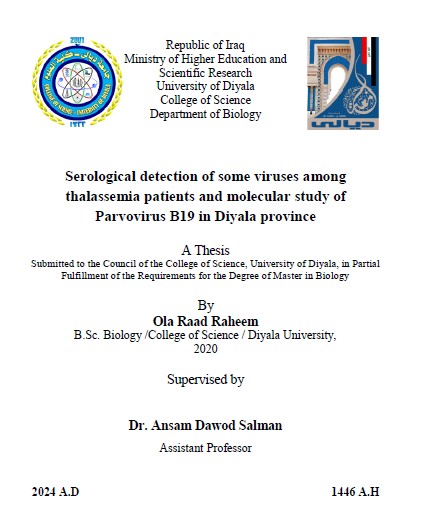Summary
Parvovirus B19, a member of the Parvoviridae family, causes a variety of medical conditions, including erythematous infection, joint inflammation, fetal hydrops, chronic hemolytic anemia that resembles thrombotic disease, and transitory crises. B19 can be transferred by respiratory secretions, blood products, and transplants. This study was conducted out from November 1, 2023 to January 30, 2024, to investigate the prevalence of Parvovirus B19 among thalassemia patients in Iraq’s Diyala province.
The current study included a patient sample of 90 persons with thalassemia and a group that served as a control of 90 presumably people in good health Sociodemographic data, as well as HBV, HCV, and HIV infection status (HBs Ag, HCV Ab, HIV Ab), were obtained, and the findings of the Parvovirus B19 ELISA detection were confirmed using real-time polymerase chain reaction. Human privacy was protected by gaining participants’ express agreement.
The current study found showed that although the anti-parvo B19 IgM positive cases were in the thalassemia major 26 versus only 2 were thalassemia minor; Nevertheless, the disparity in positive rates was not of statistical significance (30.6 % Vs 40 %, P = 0.659).
The relationship of anti-Parvo B19 IgM with other viral markers revealed that two (66.7%) of anti-Parvo B19 IgM-positive subjects also tested positive for HBs Ag. Furthermore, one (33.3%) of anti-Parvo B19 IgM-negative persons tested positive for HBs Ag, while 61 (70.1%) tested negative for both anti-Parvo B19 IgM and HBs Ag, with no statistically significant differences. The results showed that 0.0% of anti-Parvo B19 IgM-positive participants tested positive for HCV Ab in both thalassemia patients and controls.
The association of anti-parvo B19 IgM with blood indices The average standard deviation for total WBC count in thalassemia patients positive for anti-parvo B19 IgM was insignificantly higher than that of the controls who were positive for anti-parvo B19 IgM (P=0.374). On the contrary, the mean ± SD of the total WBC count in thalassemia patients negative for anti-parvo B19 IgM was significantly higher than that of controls negative for anti-parvo B19 IgM (P= 0.0001).
While the mean ± SD, some important blood indices in both study groups. Starting with the total WBC count, Findings indicated the average ± standard deviation of total WBC count was 14.33 ± 12.24 cells/cu.mm with a range of 2.31-52.05 cells/cu.mm. while the count of the control individuals was 5.67±1.12 cells/cu.mm with a range of 3.92-8.64 cells/cu.mm. The study revealed that average lymphocyte count in thalassemia patients was 8.62 ± 9.95 cells/ Cu.mm, ranging from 1.00 to 45.73 cells/ Cu.mm. In comparison, the unaltered groups had an average lymphocyte count of 2.10 ± 0.50 cells, ranging from 1.02 to 3.20 cells/ Cu.mm. The disparity among each of the groupings was highly significance P vale = [0.0001].





